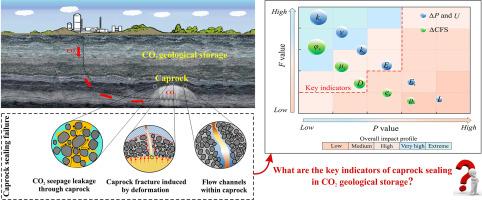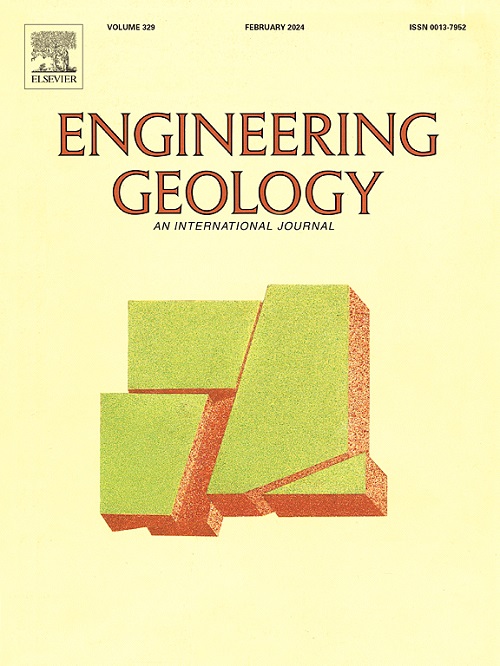Caprock sealing integrity and key indicators of CO2 geological storage considering the effect of hydraulic-mechanical coupling: X field in the Bohai Bay Basin, China
IF 6.9
1区 工程技术
Q1 ENGINEERING, GEOLOGICAL
引用次数: 0
Abstract
Caprock sealing efficiency is an essential guarantee for the long-term safety and stability of CO2 geological storage (CCS). However, the uncertainty in the physical and mechanical properties of deep formations poses challenges to accurately predict the risks of CO2 leakage resulting in CO2 breakthrough or caprock fracture. This study aims to address the issue of imperfect key indicators for caprock sealing by focusing on the CCS project in the Bohai Bay Basin, China. A hydraulic-mechanical (HM) coupling program without considering multiphase flow and the chemical reactions is secondary developed based on the finite element software ABAQUS. Furthermore, a three-dimensional finite element numerical model is established for the analysis of HM coupling, with pore pressure increment (∆PP), Coulomb failure stress (∆CFS) and displacement (U) as evaluation criteria. The Tornado analysis and response surface analysis are employed to analyze the impact of 17 indicators on the caprock sealing, including caprock thickness, burial depth, reservoir and caprock permeability parameters, and mechanical parameters. Subsequently, key performance indicators for caprock sealing are determined. The research results indicate that the reservoir permeability, injection rate, caprock permeability, caprock Young's modulus, caprock internal friction angle, caprock Poisson's ratio, and caprock burial depth are key indicators of caprock sealing capability. The reservoir permeability has a greater impact sensitivity compared to the caprock permeability. Pore pressure and displacement increase with increasing in reservoir permeability. The caprock's resistance to deformation and fracturing increases with increasing in Young's modulus and Poisson's ratio of caprock. This study provides valuable insights for evaluating caprock sealing during CO2 storage in saline aquifers.

考虑水力机械耦合效应的盖岩密封完整性和二氧化碳地质封存的关键指标:中国渤海湾盆地 X 油田
毛岩密封效率是二氧化碳地质封存(CCS)长期安全稳定的重要保证。然而,由于深部地层的物理和机械特性存在不确定性,要准确预测二氧化碳泄漏导致的二氧化碳突破或毛岩断裂风险面临挑战。本研究以中国渤海湾盆地的 CCS 项目为重点,旨在解决盖岩密封关键指标不完善的问题。在有限元软件 ABAQUS 的基础上,二次开发了一个不考虑多相流和化学反应的水力机械(HM)耦合程序。此外,以孔隙压力增量(ΔPP)、库仑破坏应力(ΔCFS)和位移(U)为评价标准,建立了水力机械耦合分析的三维有限元数值模型。采用龙卷风分析法和响应面分析法分析了 17 项指标对盖岩密封性的影响,包括盖岩厚度、埋深、储层和盖岩渗透率参数以及力学参数。随后,确定了毛岩密封的关键性能指标。研究结果表明,储层渗透率、注入率、盖岩渗透率、盖岩杨氏模量、盖岩内摩擦角、盖岩泊松比和盖岩埋深是盖岩密封能力的关键指标。与毛岩渗透率相比,储层渗透率具有更大的影响敏感性。孔隙压力和位移随着储层渗透率的增加而增加。随着毛岩杨氏模量和泊松比的增加,毛岩的抗变形和抗破裂能力也会增加。这项研究为评估含盐含水层中二氧化碳封存过程中的盖岩密封性提供了有价值的见解。
本文章由计算机程序翻译,如有差异,请以英文原文为准。
求助全文
约1分钟内获得全文
求助全文
来源期刊

Engineering Geology
地学-地球科学综合
CiteScore
13.70
自引率
12.20%
发文量
327
审稿时长
5.6 months
期刊介绍:
Engineering Geology, an international interdisciplinary journal, serves as a bridge between earth sciences and engineering, focusing on geological and geotechnical engineering. It welcomes studies with relevance to engineering, environmental concerns, and safety, catering to engineering geologists with backgrounds in geology or civil/mining engineering. Topics include applied geomorphology, structural geology, geophysics, geochemistry, environmental geology, hydrogeology, land use planning, natural hazards, remote sensing, soil and rock mechanics, and applied geotechnical engineering. The journal provides a platform for research at the intersection of geology and engineering disciplines.
 求助内容:
求助内容: 应助结果提醒方式:
应助结果提醒方式:


